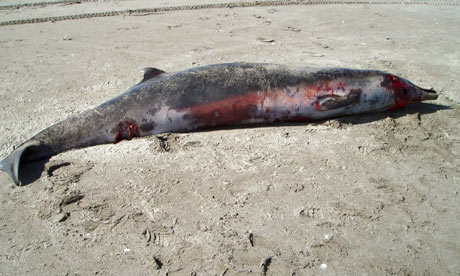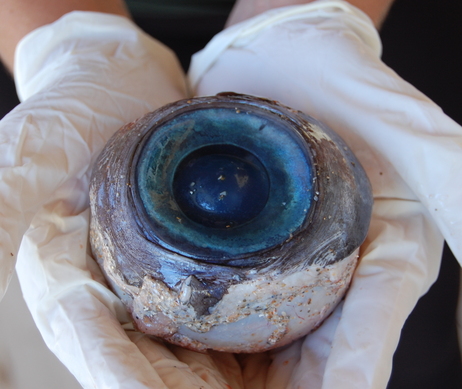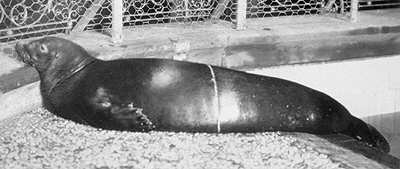I was recently in La Jolla, California to research at the Scripps Institution and attend the annual History of Science Society conference. The Scripps Institution has an archive that houses some amazing papers, including the papers of T. Wayland Vaughn (a coral specialist) and William E. Ritter (the first director of Scripps). The SIO is a fascinating institution to study, because it was built as a marine laboratory, but quickly switched its focus to oceanography and the open ocean environment. The work at the SIO is performed mostly on the open ocean from vessels; they do much less in land laboratories than they do on boat laboratories. La Jolla was a hard place to stay inside and research. Look at these views:
 |
| Sunset over the Scripps Pier. All photos from personal collection. |
Needless to say, I took a lot of breaks during my research trip. But, there are only so many days you can live with sand in your stockings before you search for a walk that won't result in such discomfort. Near the end of my research trip, I walked up to the Birch Aquarium (about a 5 minute walk from the main Scripps campus). A public aquarium has been a part of the SIO in one form or another since 1902. A public aquarium and museum were initially attached to the SIO to explain investigators' findings to the general public. In 1992, the multi-million dollar Birch Aquarium was finished on an overlook above the SIO campus.
The building looks small from the outside and I feared that this aquarium might be a let down (as most zoos and aquariums are to me). I can't say I'm a huge fan of the public aquarium; they have a tendency to be a bit boring after you've been to one. But not Birch. I think I've found my favorite public aquarium!
The Birch is tasked with translating SIO findings to the public, and imbuing that public with a sense of the diversity in the ocean, and the danger that humans pose to the marine environment. They do this beautifully. One of my favorite exhibits was the global warming tanks. It is difficult to educate the public on global warming. Give the subject too dire a sound and the viewer tunes out; paint too rosy a picture and no lesson is learned. In the global warming section of the Birch, there was a lot of writing on the walls (literally) but the most interesting pieces in the room were the two aquariums. In one, healthy corals painted a vibrant picture of underwater life: a National Geographic-esque image of the marine environment. Next to this aquarium was another, holding corals that have been bleached by the acidification of salt water (a process brought about by ocean temperature warming that is currently decimating coral colonies throughout the world). These whitish corals painted a stark contrast to the other aquarium environment, and I think, make a point that no amount of script and explanation on the walls ever could.
 |
| the kelp forest at the Birch |
 |
| "male seahorses spend most of their life pregnant" music to my eyes |
In addition to this display, the Aquarium boasts a shark tank, a touch tank, a kelp forest (amazing) and a whole room dedicated to the Birch's successful propagation of sea horses for scientific study and aquarium displays. My favorite sea horse is now the
potbellied sea horse.
By far my favorite group of aquaria was the jellyfish section. It's a given that I'm going to like a jellyfish section in an aquarium. I write about jellyfish; I'm currently obsessed with jellyfish. But, it's not a given that I will love a jellyfish section. And I love love love this one. Why, you ask? The Birch Aquarium has dedicated a lot of its resources to propogating marine organisms for study in laboratories and for trading with other aquariums. Seahorses, many species of which are slowly becoming endangered because of their supposed medicinal qualities and their use in the hobbyist community, are difficult to rear in captivity. The Birch has figured it out, and they rear and maintain these creatures in captivity to share with other public aquariums and scientists so that the wild supply need not be depleted anymore by these institutions. They focus on jellyfish for another reason.
Jellyfish are not endangered; actually, they are quite the opposite. As the oceans warm, jellyfish are thriving. And thriving is not necessarily a great thing (there is
some question about whether global warming causes jellyfish blooms). Because jellyfish are really bottomless pits of food consumption. They are the slimers of the sea. They eat a lot. And, they really know how to reproduce. So, whether the theory of warming waters and jellyfish swarms is correct, the Birch would rather be safe than sorry. They have succeeded in rearing both
Aurelia Aurita and
Cassiopea Xamachana at the Aquarium. Awesome. But they have gifted the public with tanks displaying the multiple stages of the jellyfish cycle. Mega Awesome.
 |
| Lagoon Jellies in a Kreisel Tank at the Birch Aquarium |
They have several tanks of adult jellies, including these Lagoon Jellies.
They also have a tank of polyps. The stationary lifecycle stage of the jellyfish.
 |
| Jellyfish in their polyp form. They look similar to sea anemones. |
And, they have a whole kreisel tank full of ephyrae (baby jellies that are asexually budded off of the polyp stage. I took a video because watching baby jellies is extremely calming and it's very rare to see these tiny organisms in the wild (you might swim into a group of slightly larger ephyrae while skipping school in South Florida, but that's a rare occurrence and not everyone is so lucky or unlucky).
What makes the Birch Aquarium so amazing is that they unveil the aquarist process. The tanks are free standing, and the signs explain the triumphs and difficulties of keeping these animals in captivity. And, they also give a stark lesson about why aquarists and aquariums need to try to rear these organisms. The aquarium hobby, and the exotic animal trade in general, are hard on the marine environment. We are consistently reminded that taking exotic terrestrial animals, such as lions and tigers and bears, is destructive to the ecosystem and the creature. There are laws protecting these megafauna. But rarely do zoos explain that they are breeding and rearing lions, not to be released into the wild again (a fanciful and somewhat difficult process) but so that they can be shipped to other zoos to alleviate the need for wild animals for public viewing and scientific study. And while some animals are released, on a whole, zoos breed captive animals. This releases pressure on the wild populations, provides specimens and colonies for scientific study, and educates people, but is somewhat heart wrenching- probably the reason they don't tell the viewer the stark truth. So the zoo goers get these
adorable pictures of baby animals, without the heartache of knowing that most of these animals will exist only in zoos or laboratories, bred to produce more of the same: zoo and scientific specimens. The ability to study animals in captivity leads to discoveries about wild organisms. In some instances, the zoo borns are the largest population of a species scientists
have. There are amazing reasons to breed animals in captivity. However, I'm not sure that zoo goers are apprised of all of the reasons for breeding programs in zoos. I think they are truly tricked into thinking that these animals will be released into the wild. But zoo breeding is not a re-wilding procedure.
Sea horses are taken with impunity, for medicinal, hobbyist, scientific, and public aquarium use. Jellyfish are taken, and inadvertently spread throughout the ocean, creating invasive issues and doing untold damage to marine environment. The Birch Aquarium is working to rear creatures to cut out the need to procure these creatures in the wild. I love that they show the process; and that they tell the viewer the truth. The seahorses and jellyfishes that you see, they aren't going to be released into the wild. They are going to be released into another public aquarium. Or into a lab aquarium. And that's okay. Is there a way to transfer this truthful explanation of captive breeding into the way we look at zoos? Would this hurt visitors understanding of those institutions? It's something to think about- because all lions and tigers and bears may be zoo reared in the near future. And then how do we explain the captive breeding programs?
Good on you Birch Aquarium. Beautiful. Educational. Entertaining.



























